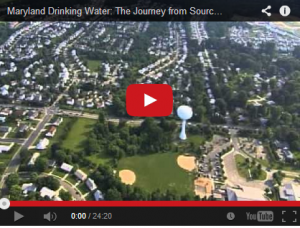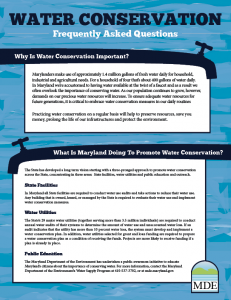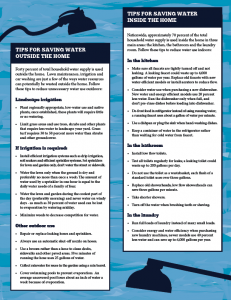Drinking Water Week 2014
More than 70 percent of our planet is covered with water, but only about 1 percent of Earth’s water is usable for consumption. And while many of us might see water as a perpetual gift that nature has bestowed upon us – always just a twist of the faucet away – our water resources are under increasing pressures and must be protected.
To mark Drinking Water Week, the Maryland Department of the Environment is renewing its commitment to ensuring that all Marylanders have safe and adequate drinking water.
“Water is our most essential natural resource,” said MDE Secretary Robert M. Summers. “I encourage all citizens and businesses to do their part to protect our waterways and groundwater from pollution and conserve water so that future generations have access to the same high-quality drinking water that we enjoy today.”
 Drinking water is vital to our public health and to the economy in Maryland. MDE is responsible for ensuring that public drinking water systems provide safe and adequate water to all existing and future users in Maryland and that appropriate usage, planning and conservation policies are implemented for our water resources. This is accomplished through proper planning for water withdrawal, protection of water sources that are used for public water supplies, oversight and enforcement of routine water quality monitoring at public water systems, regular onsite inspections of water systems and prompt responses to water supply emergencies.
Drinking water is vital to our public health and to the economy in Maryland. MDE is responsible for ensuring that public drinking water systems provide safe and adequate water to all existing and future users in Maryland and that appropriate usage, planning and conservation policies are implemented for our water resources. This is accomplished through proper planning for water withdrawal, protection of water sources that are used for public water supplies, oversight and enforcement of routine water quality monitoring at public water systems, regular onsite inspections of water systems and prompt responses to water supply emergencies.
MDE’s activities help to ensure safe drinking water for more than 5.4 million Marylanders.
You can help. Inside the home, you can save reduce water use by fixing leaks, installing low-flow showerheads and running the washing machine with full loads of laundry instead of many small loads. Outside, you can limit grass areas and landscape with trees, shrubs and native plants, which require less watering, and you can use a broom rather than a hose to clean decks, sidewalks and other paved areas. These are just some of the many ways that you can help to conserve water.
For more than 30 years, the American Water Works Association and its members have celebrated Drinking Water Week, which this year is May 5 to May 9.
Water is a finite resource and many people around the world suffer from an inadequate quality and quantity of water. These limited resources are under daily threat from increasing demand, population growth, overuse, manmade contaminants, overdevelopment, and the need to preserve and enhance water resources and infrastructure. The potential for additional droughts caused by climate change presents more uncertainty in the future.
With the enactment of the federal Safe Drinking Water Act and its amendments, the United States created one of the most comprehensive drinking water regulatory programs in the world, focusing on improving water quality, and public health protection. In Maryland, we have one of the finest water programs in the nation, based on our regulatory tools, compliance rate, and water withdrawal permitting program. In Maryland, 86 percent of the population receives water from a public water system that is inspected, monitored and regulated by MDE.
In Maryland, we use about 1.4 billion gallons of fresh water every day. We estimate that demand will go up by 230 million gallons per day by 2030. The biggest water users are public water systems, power plants and agricultural users.
MDE’s website provides tips for water conservation for business and industry, households and water utilities.


